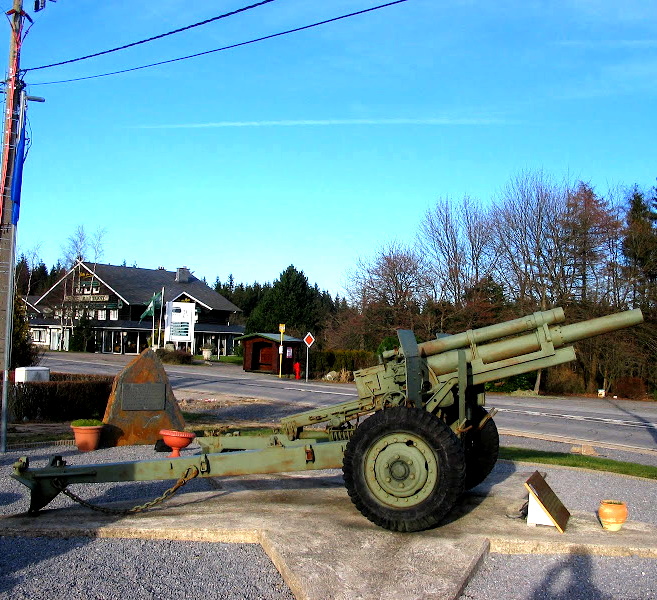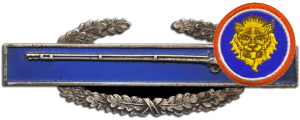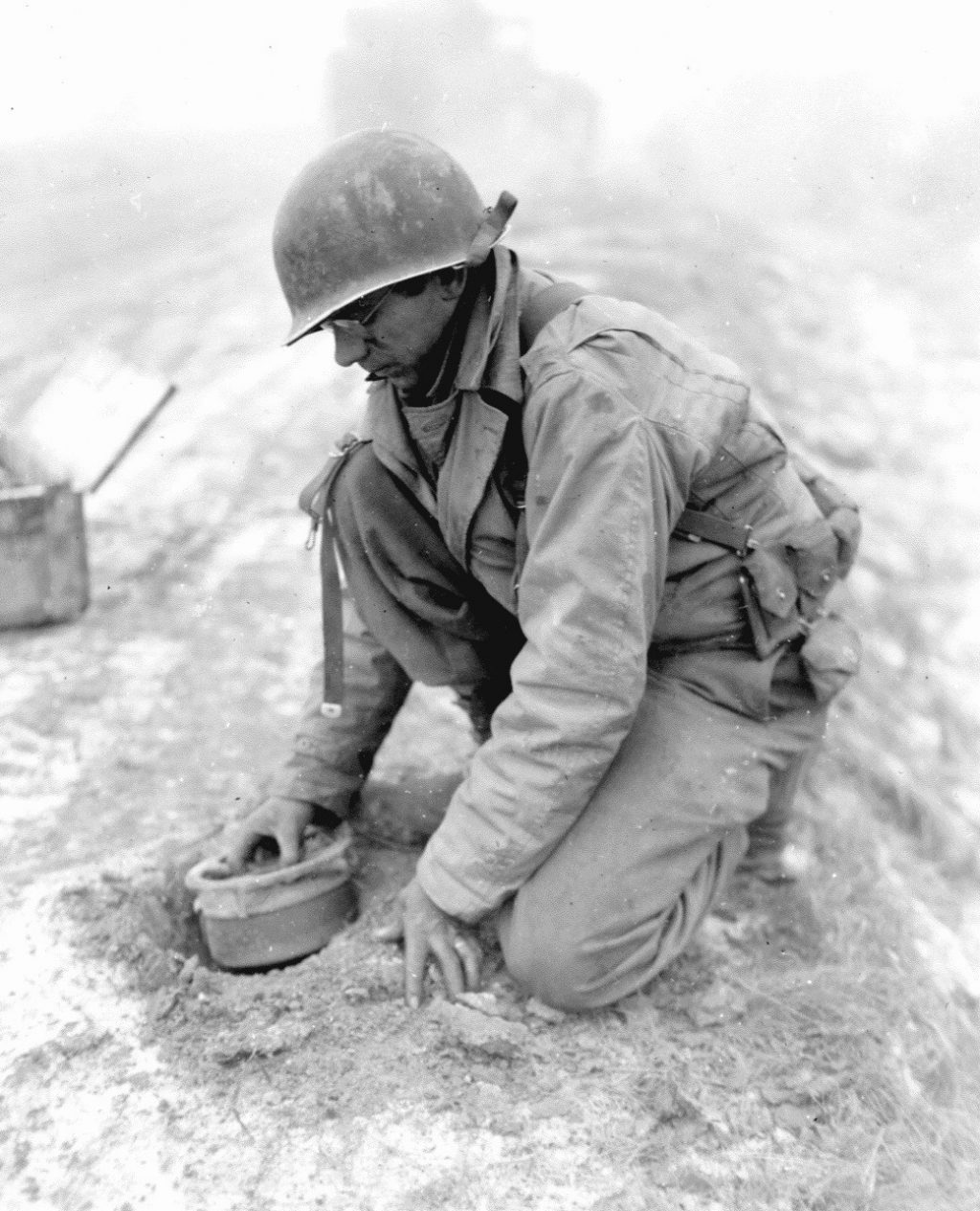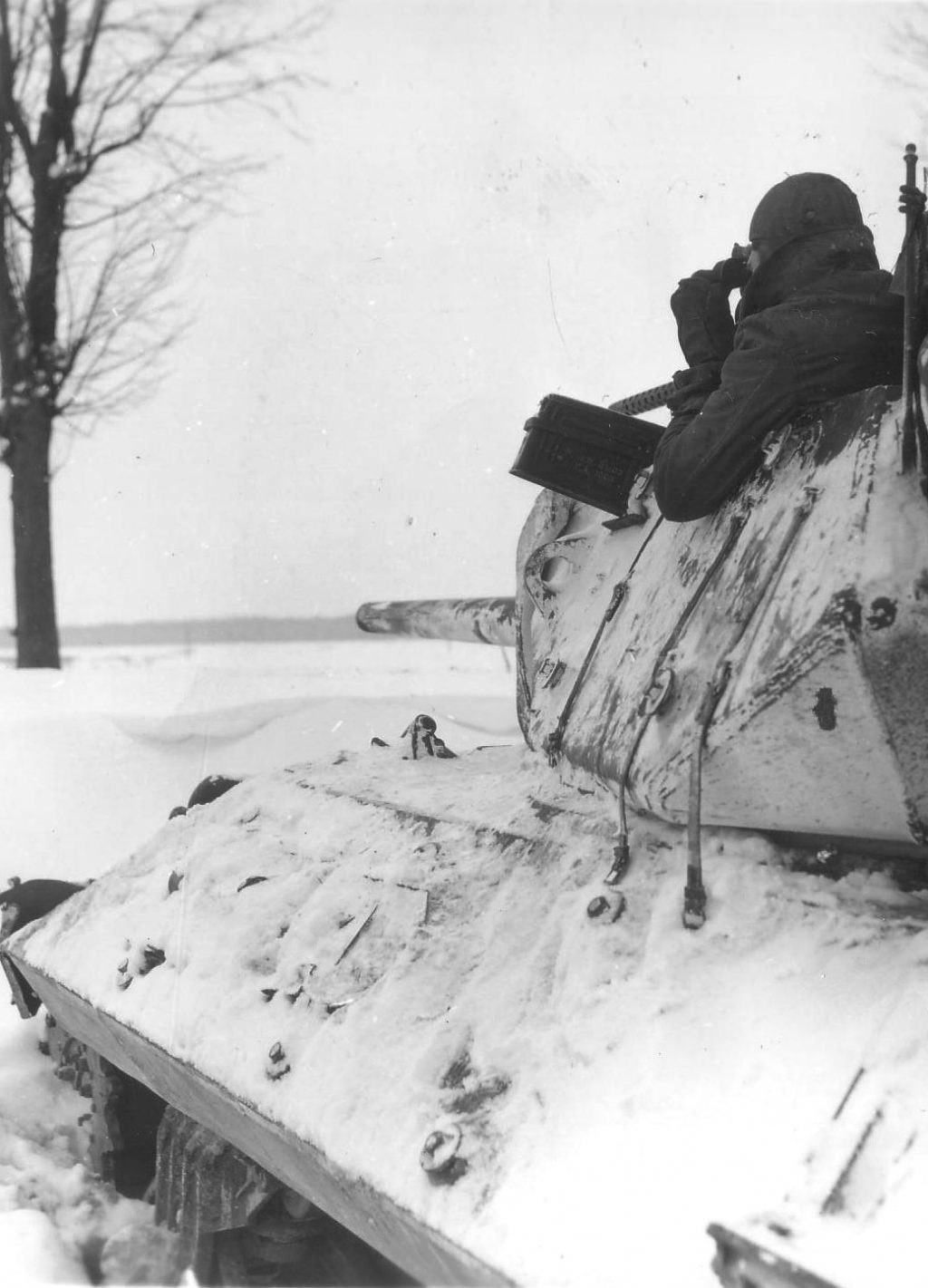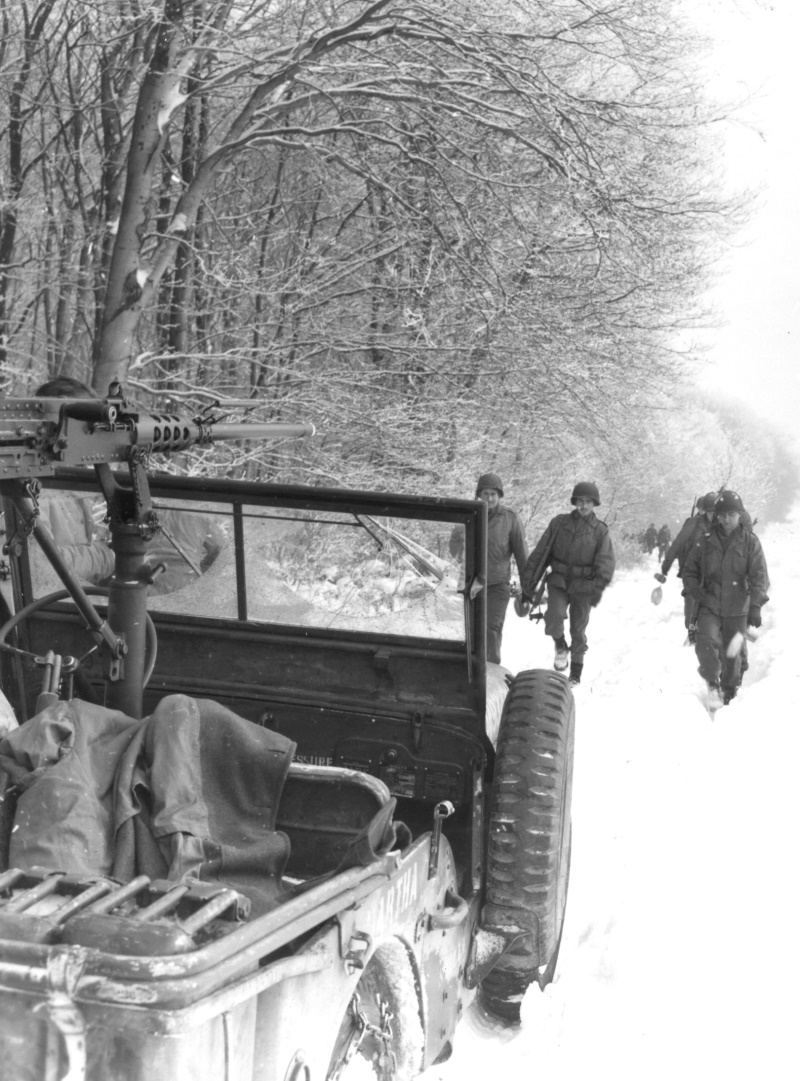There we sat in this hole in the ground just waiting and watching, until about midnight when we could hear strange noises in the fog. It was very dark and our visibility was extremely limited but we were able to discern what was making the strange noise as about a dozen Germans came into view on bicycles. They stopped in the road when they came on the mines. Being unaware of our presence, not 10 yards away, they stood there in front of us in the middle of the road – probably talking over what to do next. We could hear the language was not English and they were wearing square helmets. Sewell and I were in big trouble. This was a first for us to be this close to the enemy. Thinking that there were too many for us to take on with a carbine I took the telephone and whispered our situation to Capt Brown. His orders were as follows: ‘keep your head down, and when you hear me fire my .45 the first time we will sweep the road with the AAA quad 50s. When that stops I’ll fire my .45 again and then we will hold fire while you two come out of your hole and return to the CP. Make it quick!’ And that’s the way it happened. That German patrol never knew what hit them. On hearing the .45 the second time Ken and I left our home and keeping low, ran back toward our perimeter. I was running so hard that my helmet bounced off my head and went rolling out into the darkness. I thought, to hell with it, and never slowed down to retrieve it. I lost sight of Ken and honestly don’t remember ever seeing him again. I heard many years later that he was captured along with Bernard Strohmier and others after the Germans took the crossroads. By calling out the password, Coleman, I got safely past our defense perimeter and was then shot at and missed by somebody at the howitzer position as I approached it. After a blast of good old American obscenities, they allowed me through and I reported to Capt Brown. The official book says that there was an eighty-man patrol from the 560.VGD and the 2.SS-PD were out there that night. Maybe the rest were back in the fog somewhere.
December 20, 1944. It is cold, almost 20 degrees below freezing. The north wind is brisk. I was glad I got to spend the night in the security of the root cellar under the stone CP building. During the night, and early this morning, Maj Parker had persuaded stragglers to stand and fight with us. They were one light tank and crew from the 87-CRS; four 3-inch HVAP-AT guns and crews from the 643-TDB, four AAA half-tracks from the 203-AAA-AW Bn, 3 mounting Quad .50s, one mounting a 37-MM gun. We received our first fire mission at approximately 1500. The target was some enemy infantry entering Samrée. This was strange because our defenses were facing east and north and Samrée was to our west. We successfully completed the mission and got the report to the cease-fire, the enemy infantry was withdrawing from Samrée. Where in the hell is the enemy? Another typical situation that no one knows anything about, is SNAFU (Situation Normal, All Fouled Up). Our second activity occurred at about 2300 on the same day. Enemy infantry reported approaching our positions from the east. Alerted the quad .50s half-track covering that sector delivered devastating fire, which I watched from the road in front of the CP. It was beautiful, looked like four lines of giant fireflies chasing each other. I could not relate this beautiful sight to the carriage being created on the enemy end. A combat patrol was dispatched to mop up enemy survivors. The patrol found only one wounded German, many dead bodies, and scattered mangled bicycles. The main question is, what was this patrol doing? Why is it here? We could only guess. The wounded man died without speaking. We will never know.
December 20, 1944. Weather conditions were the same, Cold, Snowy, and Foggy. Today we positioned ourselves around the house. My buddies were busy laying land mines across the road. Others had set up machine guns. We placed our trucks which were the weapon carriers and used them for hiding or defense. We lay right underneath the trucks. That day, the Germans made their first attack. I fired my carbine from behind a truck wheel. Many Germans were wounded and would call out, ‘Comrade, Comrade’. One dead German soldier that lay approximately 50 feet from us was a very young soldier, perhaps a sixteen-year-old. Maj Parker wanted us to round up those who had been taken, prisoner. He asked me to accompany him with the prisoners as we directed them to the CP for interrogation.
December 21, 1944. I was sent forward to have a look around and found several dead German soldiers in the snow. I was not at all comfortable with that and was happy to have not found any live ones. The enemy had apparently pulled back after we had cut down their advance group the night before. All that day was spent digging and improving our defensive perimeter. We were given some warming time off and on inside the stone building being used as a CP. At one point I was detailed to guard two German prisoners that were brought in. I never learned the circumstances of their capture. One, an officer, spoke good English and warned us that the German army was coming through us and would kill anyone in the way and push the rest into the English Channel, so we could save everybody a lot of trouble by surrendering to him right then and there. At one point a Sherman tank came along and was set up in front of our CP and fired a few rounds across the field and into the forest at some distant soldiers running from tree to tree for cover. That night, after the initial attack, I recall being in my foxhole waiting for the Germans to come at us again. The realization came to me that I was involved in a really risky business. The area was lighted by the flames of a store of fuel drums bumming throughout most of the rest of the night and reflecting eerily on the snow-covered ground. The only sounds were that of the fire and the crying for help from the wounded enemies who were laying out there just out of view. I stayed in the foxhole all night and never did discover what finally happened to them, apparently their people abandoned them. Later I heard that one of our medics went out and checked on them and did what he could.
Over the years I continue to feel some responsibility for their fate since it was me who called for the fire on them when they approached the crossroads. Responsible, yes. Sorry, no. It was them or me. A lot of things go through your mind when you think that it is your time to die and I can clearly remember laying in that cold hole in the ground that could shortly be my grave thinking that I had not even experienced being in love yet. I definitely did not want to die in this strange place. I prayed to God, Jesus, and every other deity that I could think of, for help. In later years I heard the expression that, there were no atheists in foxholes. You can believe that.
December 21, 1944. Maj Parker looks bad, and really tired. He hasn’t had much rest or sleep in five days. We all are getting fatigued. It shows in the eyes. At 0530, our first serious attack began. About two platoons of enemy infantry in the forest east of the perimeter, supported by light mortar fire, seemed to be testing our defense capability. By daylight, our 105-MM and heavy automatic weapons fire had forced the enemy to withdraw. Only a single mortar continues to deliver interdiction fire into our positions. About 0800, Maj Parker dispatched the 87-CRS light tank to find and neutralize the mortar position. In a short time, the tank returned to the CP. The noncom tank commander reported to the major that the mortar had been neutralized. He then produced 5 German soldiers’ books to identify the enemy unit attacking us and as proof of his kill. This second firefight proved to the enemy that we were here and planning to stay. So far, so good. No American casualties! At about 2000, the major asked me to man an observation post for the remainder of the night. He expected an enemy build-up during the night and needed a forward observer to adjust to harassing fire. The walk to the OP was dark and frightening. The OP I manned was 800 or 900 yards east of our perimeter. I was alone except for my EE-8A field telephone, my .45 caliber pistol, and my freshly-sharpened boot knife. I wished I was back at the CP.
December 21, 1944. Fog, Snow, and Cold persisted. The next few days we were busy trying to dig our foxholes as deep as we could. We dug them around the house. Weather conditions being what they were, the ground did not cooperate with our efforts very easily. There were two of us in each foxhole and we lined them with an army blanket. Sad, but true, I do not remember who I shared my foxhole with. We were mainly concerned with surviving at that time. One of us was always on guard and so it was not a very social time. Keeping alert was crucial to survival. The feeling were ones of constant fear. Prior to my army experience, I was firmly established in my belief in God. I cannot say I thought about that a great deal. We were kept very busy with an attack occurring twice every day – one attack in the morning and another in the afternoon. The truck, just behind us, a half-track with a machine gun mounted on it, was intermittently spraying the area with machine-gun fire to flush out any snipers who might be in the area. Fulfilling our duties, surviving, and keeping warm were high priorities. I know the prayers of my family and church followed me.
December 22, 1944. Very early, in the dark, in the morning, the Germans attacked again and we were subjected to small arms and mortar fire off and on all day. At one point mortar rounds were landing really close to my foxhole and I was feeling very exposed with no helmet to crawl into. I could hear the mortar fragments smacking into the ground all around me. Most of the rounds were falling farther in toward the buildings. I saw one hit the roof of Capt Brown’s CP. It must have been during this time that Maj Parker was wounded by a fragment. I’m not sure about that. I didn’t witness it. There was a GI in a foxhole next to mine who would not fire his weapon. When I called him to fire he just looked at me. I didn’t know him and don’t know his fate either, I could not understand why he was not willing to help himself and the rest of us. I have read since that this is not an unusual occurrence. There are always a certain number who will not squeeze that trigger, even when their life is threatened.
Late in the afternoon, several tanks were heard approaching our position. Thankfully they were ours. They rolled out in the open and fired their big guns into the German positions and I thought, no problem now with all this help the day is saved. It got quiet again. And then the tanks left. Looked like we would be hung out to dry but it did stop the enemy attack for a while. Thanks, tankers. Too bad you couldn’t stay for dinner. After dark, I was moved in closer to the CP and dug another hole along with a GI named Randy Pierson. One of our guys made a run from hole to hole tossing everybody something to eat. I caught a box of wet-or-dry cereal and ate it dry. The two of us spent the night in the hole. One of us would sleep an hour and the other keep watch and then we would alternate. This was the only kind of rest that anybody got. We had dug our hole reasonably deep and then further fortified it with some fence rails that we crisscrossed in front of it. I was sure that we would be attacked that night. I had 30 rounds of carbine ammunition remaining and a knife that I placed on the ground where I could reach it. I prayed that it would not be necessary. It got very cold that night and the enemy did not attack. Another very long night. At the time the weather was our worst enemy but then in the morning things changed and the weather took second place.
December 22, 1944. The most horrifying time of my life started at 0230 when I detected vehicles moving some 2000 M east of me. We fired a heavy artillery concentration into what seemed to be an infantry assembly area. This fire mission caused both vehicles and infantry to move in my direction. To counter this movement, we fired 4 or 5 more concentrations, each one walking about 400 M closer to me. Finally, my Observation Post area was crawling with enemy infantry, moving furiously to stay ahead of the exploding shells. To my dismay, this walking barrage was soon delivering ground-shaking tree bursts directly over my head. I was not detected by the preoccupied enemy infantry as they passed me, but my EE-8A was blown to bits. I lost contact with Battalion Hqs! Direct fire from our 105-MM howitzers, the 3-inch AT guns, coupled with automatic weapons and small arms fire caused the German infantry to withdraw about one hour later. It was still dark. This time the enemy infantry passed over my position while in retreat. Fortunately, I, again, was not detected. Later, when I felt somewhat secure, I decided to try to return to the perimeter without getting killed. As I was about to leave my hole, I heard a noise. Then a German helmet fell into the hole, followed by a sweaty-smelling, heavy-breathing body. With my adrenaline flowing, I frantically stabbed and sliced until there was no movement. Exhausted, I remained under the warm, bleeding body for quite some time. Desperation finally drove me to work my way back to our perimeter. I thanked God that I was not shot by, either friend or foe during the journey.
My arrival at the perimeter was about 0600, only minutes before the start of the second German attack. This attack lasted almost one hour and I was pressed into service as an ammunition handler for a .50 caliber machine gun position. Another unnerving experience! Upon my arrival at the CP at about 0800, I was warmly greeted. The guys thought their barrage or the enemy had killed me. When they noticed my bloody uniform, they thought I had been wounded. Reports from the perimeter advised Maj Parker the perimeter was secure, but we had sustained WIAs. At 1155, Maj Parker received permission from Division to disengage and withdraw the 589-FAB troops to Manhay to draw new supplies from the 3-AD. The Major declined to leave, although the scarcity of ammunition concerned him. During the afternoon, Maj Parker sustained serious wounds, and shell fragments in the chest. That night, over his objections, he was evacuated in a half-track.
